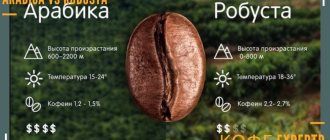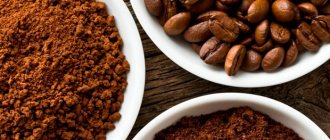What are Arabica and Robusta
Arabica and Robusta are evergreen coffee trees belonging to the coffee genus of the Rubiaceae family. The trees grow in equatorial climates, mainly in Africa, Asia, Central and South America. Arabica was born as a result of a natural crossing of two types of coffee: Eugenioides and Robusta. Yes, Robusta is the parent of Arabica. Details of their relationship, who appeared, how and where, can be found in our articles about Arabica and Robusta, and we will move on to the essence of the article.
Rules for choosing genuine Arabica beans
An important condition for a tasty coffee drink is the purchase of properly roasted beans. There are some simple tips on how to choose quality coffee:
- One important distinguishing characteristic of black arabica should be a certain aroma. The excellent quality of this variety is accompanied by a multifaceted aroma. Old coffee beans lose their rich aromatic notes. The taste of the drink also weakens.
- The best beans are dry and uncracked beans. If the grains are too dark and greasy, this may indicate their poor quality.
- Regardless of the type of roast, the beans should be large, round and uniform in appearance.
- It is believed that high-quality goods are sold in vacuum packaging.
- First of all, before purchasing, it is better to study the manufacturer’s information. Additional information contains: country of origin, variety name, degree of roasting, date and time of harvest and packaging.
- The pack may contain a mix of varieties. The beans may have been grown in one country, but during production they mixed different coffee varieties that differ in characteristics and caffeine content. The packaging will also say “100% Arabica” and it is impossible to find fault here, because all these beans are grown on trees belonging to the same botanical species.
Basic historical facts
- Place of discovery: The first mentions of Arabica were in Ethiopia, and Robusta in Uganda.
- Places of growth: Arabica is cultivated in America, Africa, Asia, the Caribbean and Oceania. Robusta is mainly cultivated on an industrial scale in Asia and Africa.
- Leader in production: Leader in Arabica production - Brazil, Robusta - Vietnam.
- Share in world production: 70% of the world volume belongs to Arabica, 30% to Robusta.
- Characteristics of the coffee tree
- Tree height: Arabica can grow up to 10 meters, robusta up to 15 meters.
- Growing altitude: Arabica grows from 900 to 2500 meters above sea level, robusta grows lower, from 200 to 900 meters.
- Resistance to parasites and diseases: Arabica is less resistant to diseases, robusta, on the contrary, has high resistance to parasites and diseases.
Varieties (varieties) of Arabica
First of all, it is worth understanding how a variety of Arabica can appear. Basically there are two ways:
- Natural. This is either a natural crossing, which is how Arabica appeared, or a natural mutation, which is how bourbon and maragogip appeared, which we will talk about later.
- Artificial. If with the natural method everything is clear, nature does its job, then with the artificial one it is man who takes part. Its goal is “on the surface”: to develop a new variety of coffee tree that will be productive, susceptible to parasites and, most importantly, produce delicious coffee. This method is called selection.
It is also very important to understand that the genetic base of coffee is quite poor, since long ago, only one variety of Arabica, Typica, went on a trip around the world. And today, the bulk of world Arabica production relies on about 25 varieties, mostly derived from evolutions of that same type. Now, we will talk about the most famous representatives of Arabica:
- Bourbon is the first noticed natural mutation of Typica, which was discovered on the island of Reunion, the then name was Bourbon, hence the nickname. Basically, the historical logic behind the name of coffee largely depended on the location in which the coffee tree with the new mutation was discovered.
- Caturra - this mutation was discovered in Brazil in the mid-20th century. The new tree turned out to be more productive than typica and bourbon, and also lower, which made it easier to pick berries. Soon, Caturra spread throughout the American continent, pushing Typica and Bourbon into the mix.
- Maragogyp – This coffee is very popular, especially in stores. It is called “elephant grain” and is bought with “the eyes”. It appeared in the Brazilian state of Bahia, near the city of Maragohipi
There are about 120 other varieties of coffee: Liberica, Geisha, Rume Sudan, Timor, Moka, Catuai, Blue Mountain, Sln 32 and others. If you are interested in “dig” deeper, then the article “Types and varieties of coffee | What are they and how many of them exist” will help with this. See you soon.
Bean price
It is difficult to give a definite answer regarding the price of both varieties. Most often, Arabica costs twice as much as Robusta. The cost depends on the effort spent on growing a particular variety, as well as on the taste of the resulting coffee. Arabica requires more careful care, but at the same time has a higher taste. Robusta usually costs less: it is unpretentious to grow, but its taste is much harsher. However, you should not determine the type of coffee based on its cost: sometimes sellers can price Robusta more expensive than Arabica, since the quality of the crop is much higher. Raw materials and their quality can significantly affect the final cost of coffee.
Where does Arabica grow today?
Arabica coffee grows best in tropical climates around the equator
The place where the coffee tree grows, as in the case of grapes, affects the taste and aroma of the finished coffee. Arabica is grown in almost 40 countries, and each country produces its own varieties.
Due to the burning direct rays of the sun in South and Central America, the plant is planted under the shade of local trees.
Brazil is one of the largest producers and exporters of coffee in the world. Brazilian coffee has a traditional taste and harmoniously combines strength and softness.
Colombia produces some of the best coffee beans and is the second largest Arabica producing country. Colombian coffee has a velvety aroma, refined, light taste and a delicate nutty aftertaste.
Typica, Bourbon, Caturra and many of their descendants are subspecies of the same botanical species of coffee trees - Coffea Arabica
Kenyan coffee is among the best. The increased iron content in the soil gives high acidity to the grain; these are the most acidic Arabica varieties. And citrus shades only emphasize this sourness, making the bouquet richer.
Indonesia grows the sweetest Arabica beans, with notes of honey and cardamom. Some varieties have an aroma with hints of hot spices. Arabica varieties grown on the islands of Indonesia are practically devoid of acidity.
Costa Rica grows mild coffee with less caffeine. The volcanic soil gives a balanced flavor to the coffee beans. This is coffee with a subtle floral aroma and nutty notes. Most varieties contain additional vanilla and fruit notes. It is noteworthy that in Costa Rica it is prohibited to grow Robusta - only Arabica.
Guatemala. Arabica from Guatemala is a balanced bouquet of shades. Citrus sourness is harmoniously complemented by chocolate and floral notes. Some highland coffees have a richer, astringent taste, with a slight bitterness and hints of smoke.
The homeland of Arabica is Africa. More precisely, Ethiopia, and more precisely, the area between Kenya, Ethiopia and Sudan
Ethiopia, the birthplace of coffee, still provides the world with tart, spicy coffee with a wine-like undertone. The coffee has a rich taste and a long aftertaste. Coffee trees are grown by peasants in the mountains, on small farms.
The Dominican Republic grows not very expensive, but high-quality coffee. Very mild taste, light vanilla and nutty notes. Ideal for coffee with milk or cream.
Coffee in India is grown in the south. The beans produce a delicate, soft coffee filled with a sourish wine taste. These are some of the richest Arabica varieties. Spices, cardamom and cinnamon are often planted next to coffee trees, which give the spicy aroma of coffee.
These countries are the most popular exporters around the world, producing quality beans that are then transformed into aromatic coffee in your cup.
Characteristics of coffee beans
- Bean shape: Arabica has a more elongated shape, Robusta is more round.
- Caffeine content: Arabica has half the caffeine content, 1-1.5%, than Robusta, 2-3%.
- Content of essential oils: Robusta contains half as much essential oils (8%) as Arabica (18%).
- Sugar content: Robusta contains two times less sugars (5%) than Arabica (8%).
Taste and aroma
These two varieties have completely different taste characteristics. Arabica is considered a softer drink that is practically not bitter. Robusta is much coarser than its counterpart, but in some varieties you can feel other notes of taste.
Sweetness
Sweet notes are, in principle, not characteristic of any type of coffee. Only some varieties may contain such notes: Indian Robusta (you can feel the nutty-chocolate flavor), Yemeni Arabica (chocolate flavor), etc.
Kislinka
The sourness is characteristic of the Arabica variety, since Robusta practically does not carry this shade, with the exception of the Indian version. Wine sourness can be felt in the Mayosor variety, and the berry aftertaste is characteristic of Guatemelian Arabica.
Bitterness
Arabica is practically not bitter - this property is more typical of robusta. This type of coffee is generally harsher in taste. There are small exceptions in this case: in Zambian Arabica you can feel a slight bitterness.
Size and appearance
The appearance of Robusta and Arabica is also very different from each other. However, if you know their main distinguishing features, then determining what exactly is in front of you will not be difficult.
- Arabica has oval-shaped grains, the size of which is about 7-8 mm. After the beans are roasted, they become uniformly brown in color.
- Robusta grains are more rounded and smaller in shape - their size is no more than 6 mm. After roasting, a large number of brown shades appear on the beans, so even after processing it is not difficult to distinguish between these two varieties.
Popular varieties
To put it correctly, Arabica is not a variety of coffee, but a type of coffee plant. Therefore, it is divided into a large number of varieties: Typica, Bali, Bourbon, Katura, Aramosa, Shinzan, etc. Each version of this coffee has its own specific features and aroma. Arabica is a classic type of coffee, which is why there are so many varieties based on it. Robusta does not boast as many varieties: these include Quilu, Ambry and Conillon du Brasil.
About the plant Coffee tree
Arabica coffee, beloved by many, comes to stores from high mountain plantations. The homeland of these coffee beans is Brazil or sunny Latin America. Arabica varieties also arrive on our shelves from India, Ethiopia and Indonesia. There is no frosty weather in any of the tropical countries mentioned above - the average temperature is from 15 to 24 degrees. The soil in these regions is rich in minerals due to the rainy seasons. High-quality beans always grow at sea levels ranging from 600 to 2000 meters and above.
The Arabian coffee tree is a typical plant that grows in hot tropical countries. For high-quality fruit growth and the formation of a rich grain harvest, excessively hot conditions are unacceptable for the Arabian tree. The ideal environment for this plant is the cool, shaded heights of mountain valleys. Arabian Tree Facts and Growing Features:
- under natural conditions, the crown height is from 6 to 8 meters;
- Trees bear fruit for 20-25 years;
- if cultivation occurs in an artificial environment, then breeders do not allow the crown to grow above 4 meters;
- after the rainy season, white flowers resembling jasmine inflorescences bloom among the green foliage;
- The flowering period is 8-9 months;
- Arabica fruits are dark red and spherical in shape;
- The harvest is harvested by hand due to the fact that flowers and fruits grow on the tree at the same time - they cannot be damaged.
Coffee does not have an abundance of productivity. The annual coffee harvest does not exceed 5 kg and 1 kg of it is roasted for sale. Arabica coffee beans are a “container” of chemical components and substances that form the taste of the contents of a coffee cup. The main components in the aromatic and flavor set of Arabica coffee are caffeine (1.2-1.3%) and aromatic oils (≈18%).
Areas and purposes of application
- In espresso coffee blends: Arabica is added for acidity, sweetness and aroma. Robusta for bitterness, density, strength and creams.
- In single-origin coffee: Arabica is suitable for those who like more acidic and aromatic coffee. Robusta is for those who like it stronger and appreciate bitterness in taste.
- In instant coffee: Mostly the cheapest, low quality coffee and Arabica and Robusta are used.
- In flavored coffee: Often the cheapest coffee is used, but sometimes more expensive items are flavored, both Arabica and Robusta.
Dependence of the taste of Arabica on the method of processing the beans
The rich taste and delicate aroma are the result not only of the grade of coffee, but also of the processing method that was applied to the collected beans. Coffee fruits are processed:
- Dry method - dry in the sun, regularly turning and mixing the grains. During natural drying, the fruits are saturated with moisture from the drying shell and acquire an unusual fruity-citrus taste. The dry processing method gives Arabica a rich, sweetish flavor with many tones and shades. Sun-dried grains are packaged as NATURAL, DRY PROCESSED, DRY or DP. Unfortunately, not all farmers adhere to the correct technology. If coffee is dried directly on the ground, it will impart an earthy smell and flavor, leading to a serious loss of quality characteristics.
- Wet method - the berries are soaked in water for 24 hours, after which special machines clean the shell. The resulting coffee shares are again placed in water, but now with the addition of yeast. Drowned grains are considered fit for consumption. This technique removes some of the flavor from the coffee and is marketed as WASHED, WET, PROCESSED or WP.
- Honey or semi-washed - part of the shell is peeled off immediately using wet processing. The remaining protective layer imbues the coffee with flavor and aroma and is removed after drying. The result is an optimal balance of taste and aroma.
The processing method does not always guarantee excellent coffee quality. Improper transportation or storage can worsen the taste.
Why is it considered that Robusta is worse than Arabica?
Among coffee lovers you can often hear the opinion that Robusta is much worse than Arabica, which means it is almost impossible to drink. In fact, the reasons for this stereotype are several factors:
- Robusta cannot offer such a variety of flavors and varieties, unlike Arabica;
- Huge difference in price: Arabica usually costs twice as much as Robusta;
- Conditions for growing varieties: usually they don’t spend a lot of time and effort on Robusta, so the quality of coffee can be much lower than that of Arabica.
Arabica bean shape
Russian people like to buy “with their eyes” and when they see a large coffee bean, they believe that they need to choose it, it is the most delicious. This life hack is not always correct; when choosing olives, yes, but not for coffee. For example, we roast more than 15 types of Arabica from different parts of the planet, and they are all different in shape and size: Ethiopia Yirgacheffe is quite small, Nicaragua Maragogipe is huge, and Brazil Santos is something in between. And all these are Arabica, and they are united by an oblong-oval shape. A little later, speaking about varieties of Arabica, we will understand why this happened in nature. By the way, our full range of Arabica beans can be found in the corresponding section.
Which is better Arabica or Robusta
Only one person can answer this question, you will find him in the mirror. After all, taste is a very subjective thing, everyone has their own. For one, green apples will be sour, but for another, on the contrary, just right. Therefore, you can only get to the bottom of your truth through trial and error. The only thing is, choose a good supplier, not store-bought coffee, but a company that roasts it itself, knows what’s inside its pack, will tell you about the coffee and help with the choice. It is important.
Summary table of differences between Arabica and Robusta
To summarize our comparison of the two varieties, let’s record all the distinctive features in a table.
| Arabica | Robusta | |
| Homeland of origin | Ethiopia | Congo River Basin |
| Share of coffee variety in the world market | 75% | 25% |
| Features of care and cultivation | It grows at altitudes of 800-2200 meters above sea level, requires special care, as it is vulnerable to diseases and negative environmental influences | It grows in valleys and at altitudes up to 600 meters above sea level. It does not require much effort to care for and has its own protection against diseases. |
| Pollination method | Cross | Self-pollination |
| Appearance of coffee | The grains are oval in shape, up to 8 mm in size. After frying, the brown color is distributed evenly | Round bean shape, uneven color after the roasting process, small size. |
| Taste | Several types of varieties with different tastes: mostly soft, with sourness | Hard taste with slight bitterness |
| Aroma | Strong and pleasant | Subtle |
| Fortress | Medium, low | High level |
| Price | It costs more than robusta because it requires more resources to grow. | Arabica is twice as cheap. |
How to brew Arabica coffee correctly
Photo by samer daboul from Pexels
The best way to prepare delicious coffee from Arabica beans is considered to be brewing in a Turk. The recipe for making the drink is simple:
- 2 tsp is poured into the bottom of the Turk. ground coffee and fill with water.
- Heat the drink over low heat until the foam rises.
- Cool slightly and put on low heat again.
In both cases, boiling should not be allowed, which destroys the foam and contributes to the volatilization of essential oils.
What to choose: Arabica or Robusta
Selection of Arabica and Robusta. As we said earlier, delicious coffee is different for everyone, but we can only give a couple of recommendations for navigation when choosing your ideal cup:
All the recommendations given below are valid provided that the coffee is not heavily roasted, because if it is, then it doesn’t matter whether it’s Arabica or Robusta, everything will be the same: ashy and very bitter.
If you like more acidic coffee with a bright aroma, then try Arabica. Moreover, Arabica beans are also different; African beans will be more sour than, for example, those from Asia. As a rule, all roasters indicate the characteristics of each variety; look at them, this will help with your choice. Here, for example, is our assortment of Arabica beans.
- If you like your coffee stronger so that the bitterness dominates the taste, then try Robusta. Robusta is good coffee, it is popular, inexpensive, and those who “throw mud at it” are simply showing vanity. We roast only one variety of this coffee - Uganda Robusta.
- If you've read both of the previous points and think you need something in between, then take a look at espresso blends. Moreover, choose the one where the ratio of Arabica and Robusta seems optimal to you. We blend seven espresso blends with different percentages, which can satisfy the gastronomic needs of 99% of coffee lovers. At least that's what we think)
- If you read this article carefully, and not through a diagonal line, then you are more likely to know which coffee to choose.
But if you still have doubts, then write to us, we will help) See you soon.
Subtleties of taste of Arabica beans of varying degrees of roasting
You can achieve a noble, high-quality taste and rich aroma of sour coffee through proper roasting and preparation of the drink itself. Popular options for roasting beans have the following characteristics:
- A low degree makes the roasted grains light brown in color. The aroma is not pronounced. There is slight acidity.
- Medium roasting makes the grain dark brown in color. The aroma becomes rich and rich, and the coffee tastes sweet after brewing.
- The degree of high roasting makes the beans almost black. If you roast coffee beans using this method, essential oil will be released. The smell of coffee is strong and pleasant, and the bitterness is very noticeable.
- Italian roasting of beans involves exposing the beans to high temperatures. Each grain is black in color and oily due to the oil it exudes. This type of roasting is necessary to produce espresso coffee with a strong hint of bitterness.
How to choose the best bean coffee?
When choosing coffee, focus on 4 main parameters:
- manufacturer country;
- brand;
- view;
- degree of roasting.
Brazil and Colombia supply simple but delicious bean coffee in a classic design. Colombian can have light fruity notes. Ethiopian beans are slightly sour, while Caribbean beans leave an incredible coffee aroma.
The most famous coffee brands
The world's best bean coffee brands:
- Malongo;
- Lavazza;
- Kimbo;
- Gaggia;
- Saeko.
Lavazza
Malongo
As for appearance, the grains must be whole, without chips. If they are sold in sealed packaging, pay attention to the expiration date.
Which varieties are the most delicious?
Coffee lovers' taste preferences vary. It would be wrong to say with confidence that one variety is better and the other worse. But there are types of coffee that are extremely expensive on the market, which makes them exclusive and especially valuable. The top most expensive varieties include:
- Black Ivory. A cup of the drink costs about $50, and a kilogram of grains costs about $1,000.
- Kopi Luwak - 50 grams of grains costs $70.
These coffees are prized for their incredibly rich flavor compounds. To obtain an unusual taste, the grains are fermented. Black Ivory passes through the digestive tract of elephants, and Kopi Luwak picks up enzymes in the stomach of musangs.











